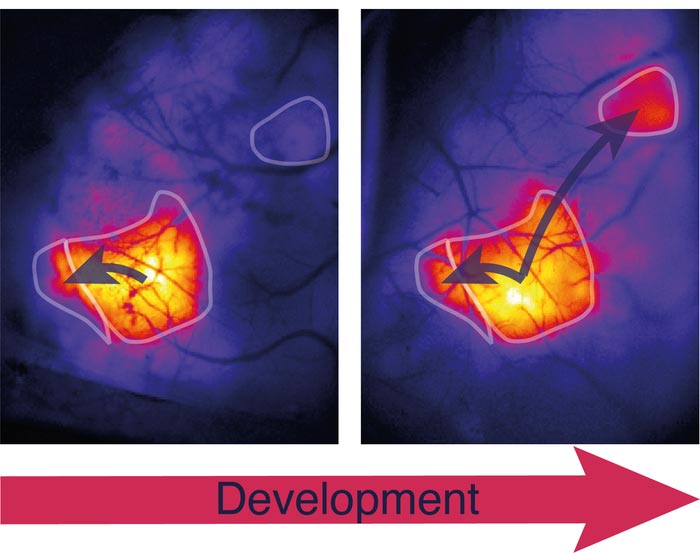Brain connections have their own tempo

The activation of cerebral cortex areas increases progressively during postnatal development. In this study, the authors unraveled the genetic bases for the establishment of such connectivity.
Credit: © UNIGE – Laboratoire Denis Jabaudon
Scientists at UNIGE show that during development, the different populations of neurons needed for connections between brain areas share similar genetic programs, but which unfold at different speeds.
The cerebral cortex, located at the surface of the brain, handles the cognitive, language, and complex functions that allow us to represent the world or project ourselves into the future. By being able to categorize and associate the stimuli it receives from our five senses, the cortex links this information together to make sense of it. To do this, different types of neurons establish cortical connections during embryonic development and early postnatal life. What is the biological mechanism by which this delicate assembly is created?
A team from the University of Geneva (UNIGE), Switzerland, has now deciphered this process: although neurons are anatomically distinct, their genetic programs remain very similar. It turns out that the differences emerge during the molecular maturation of these neurons, which must follow a precise rhythm to establish the right connections. These surprising results can be discovered in the journal Nature.
The various functions managed by the cerebral cortex are not randomly distributed, but instead are organized according to a precise map. For instance, visual areas are located at the back of the head, while touch is represented on the side, and motor control in the front. To perform their different functions, however, these areas must communicate effectively. “And this is continually verified: to catch a ball, for example, visual and motor areas must coordinate”, explains Denis Jabaudon, a professor in the Department of Basic Neurosciences at the UNIGE Faculty of Medicine, who led this research. These connections are essential for human beings to construct a coherent vision of the world. However, choices must be made so that associations are not erroneous and the most useful associations are selected.
A common genetic partition played at a different tempo
Connections between cortical areas are provided by so-called ‘inter-areal cortical projection neurons’ (ICPN), which send electrical signals to their cortical target(s). “For cortical areas to communicate, the system must connect precisely”, Denis Jabaudon points out, “and for this to happen, different types of connections must be established at the right place and at the right time.” To understand how this phenomenon takes place, Dr Esther Klingler, a researcher in Denis Jabaudon’s team, and their colleagues studied how the connections between the areas responsible for touch and motor skills are established in mice after birth. “To our great surprise, the genetic programs of the two ICPN populations were not different overall, despite their anatomical dissimilarities. However, the tempo governing their expression varied considerably.”
Thus, neurons making connections of a given type develop more rapidly, while others developing more slowly, connect to other cortical areas. “Our work suggests that creating diversity in neurons does not always require major genetic diversity. It seems that in this case, the score sheet is similar, only the rhythm of the music changes.”
To confirm their discovery, the scientists modified the execution of this genetic program by expressing, over a long period of time, a gene that is normally expressed only at the beginning of the process. Mice then showed abnormal sensorimotor connectivity, as well as an unusual exploration of their environment. This single change disrupted the entire system.
Touch-movement relationship comes first
Distinct neuronal types thus have distinct maturation rhythms, that are reflected in the order in which connections between brain areas appear. “In mice, active exploration of the environment only emerges progressively during the first two weeks of life, corresponding to the order of connections between the corresponding brain areas”, Denis Jabaudon explains. “The sequential development of these different neurons allows sensory abilities to emerge according to a similar schedule: the newborn mouse first needs to suckle — and will, therefore, first develop the touch relationship — and then to move, it will develop motor abilities that are processed by other cerebral areas.” Step by step, the cortex learns to establish connections only when they are necessary, to be able to process the information correctly. In the brain, too, there is a time and place for everything.
Journal: Nature
DOI: 10.1038/s41586-021-04048-3
Method of Research: News article
Subject of Research: People
Article Title: Temporal controls over interareal cortical projection neuron fate diversity
Article Publication Date: 9-Nov-2021
All latest news from the category: Life Sciences and Chemistry
Articles and reports from the Life Sciences and chemistry area deal with applied and basic research into modern biology, chemistry and human medicine.
Valuable information can be found on a range of life sciences fields including bacteriology, biochemistry, bionics, bioinformatics, biophysics, biotechnology, genetics, geobotany, human biology, marine biology, microbiology, molecular biology, cellular biology, zoology, bioinorganic chemistry, microchemistry and environmental chemistry.
Newest articles

Innovative 3D printed scaffolds offer new hope for bone healing
Researchers at the Institute for Bioengineering of Catalonia have developed novel 3D printed PLA-CaP scaffolds that promote blood vessel formation, ensuring better healing and regeneration of bone tissue. Bone is…

The surprising role of gut infection in Alzheimer’s disease
ASU- and Banner Alzheimer’s Institute-led study implicates link between a common virus and the disease, which travels from the gut to the brain and may be a target for antiviral…

Molecular gardening: New enzymes discovered for protein modification pruning
How deubiquitinases USP53 and USP54 cleave long polyubiquitin chains and how the former is linked to liver disease in children. Deubiquitinases (DUBs) are enzymes used by cells to trim protein…



